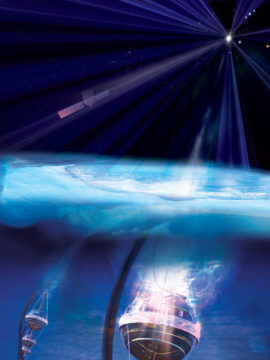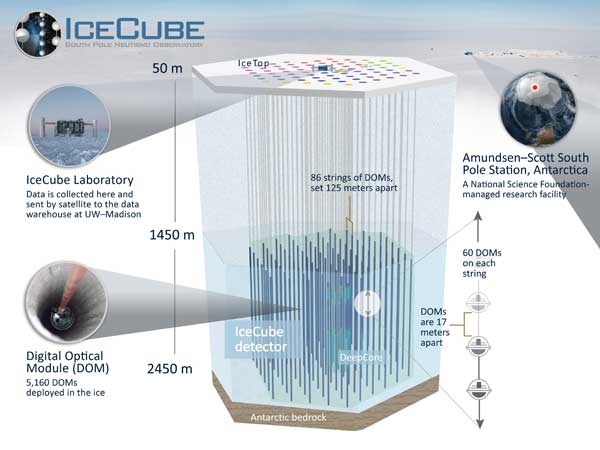A combination of neutrino detection and observations across the full spectrum of light has pinpointed a cosmic accelerator for the first time, revitalizing multi-messenger astronomy.

NASA / Fermi and Aurore Simonnet (Sonoma State Univ.)
A single infinitesimally small neutrino – a point-like particle with no electrical charge and almost no mass — that the IceCube Observatory in Antarctica detected on September 22, 2017, has made a big impact on the science world since its source was announced to the public on July 12th. Dubbed IceCube-170922A , not only is it the first high-energy neutrino to be traced back to its probable birthplace, but it’s also a major step forward for multi-messenger astronomy.
The Neutrino from a Blazar
After traveling through space undeterred for billions of years, IceCube-170922A finally met Earth. It ghosted through our planet unnoticed — just like the trillions of neutrinos passing through your body right this second — but then something unusual happened: it crashed into an atom and disappeared, spitting out a muon in the process. It was the dim, bluish light emitted by the muon that IceCube detected. Scientists backtracked from this signal to figure out from which general direction the neutrino came. By 43 seconds post-detection, this location on the sky was sent to telescopes around the world for follow up.
Within four hours the space-based Neil Gehrels Swift Observatory identified a blazar called TXS 0506+056 as a possible source, lying a staggering 3.7 billion light-years from Earth. In its host galaxy, this supermassive black hole sends out twin jets of high-energy radiation, one of which happens to be aimed at Earth. The Fermi Large Area Telescope soon reported that this blazar was flaring, emitting a huge amount of high-energy gamma rays. Next, the MAGIC ground-based telescope – observing even higher energy gamma rays – confirmed Fermi’s result. Finally, observations from 20 telescopes detected a blip in electromagnetic emission across the spectrum.
This investigation represents a way to probe the highest-energy processes in the cosmos using not only electromagnetic radiation (such as light or gamma rays), but also neutrinos. Even though such a multi-messenger technique was first used in 1987, when three neutrino observatories detected 25 neutrinos after a star in the Large Magellanic Cloud went supernova, the feat hasn’t been duplicated since. In contrast, the IceCube neutrino offers hope of utilizing multi-messenger astronomy to probe a host of common (and largely far-away) cosmic accelerators, prompting NSF Director France Córdova in a press conference to say: "The era of multi-messenger astrophysics is here."
Questions Remain
Yet a number of questions remain. The first and most obvious one is whether scientists can say with certainty that TXS 0506+056 is indeed the neutrino’s source. After all, no neutrinos have been detected from flaring blazars that are much closer to Earth, like Mkn 425 and Mkn 501. “Based on 10 years of data from IceCube and Fermi, we evaluated the probability [that TXS 0506+056 is the neutrino’s source] in multiple ways,” says IceCube Principal Investigator Francis Halzen (University of Wisconsin, Madison). The team calculated a chance of only one in a thousand that the detection would turn out to be a random fluctuation in the signal.
Now having an object in the sky for reference, IceCube scientists next trawled through their archival data. The search proved fruitful, uncovering 19 neutrinos in 150 days between 2014 and 2015 that came from the blazar with even more certainty. “On top of that, both neutrino and photon data measured in 2014-15 and 2017 show the characteristic spectrum expected from a cosmic accelerator,” adds Halzen.
However, while the TXS 0506+056 association is highly likely, it’s still uncertain. Kohta Murase (Penn State) urges caution: “If we look at history, there have been many claims for which such a level of significance eventually went away,” he says. “Definitely, we need more events to establish that blazars are sources of neutrinos.”
An Ultra-High Energy Source?
Another crucial question is whether the new neutrino results hint at the blazar being a possible source for a different type of mysterious particle: ultra-high energy cosmic rays (UHECRs). These extremely energetic and rare particles are protons and nuclei with energies above a million trillion electron volts — the Large Hadron Collider would need to be the size of Mercury’s orbit to accelerate a proton to the energy of the most powerful UHECRs. UHECRs travel at tremendous speeds through the cosmos and occasionally rain down on the Earth. Although these cosmic rays are delayed by millions of years through deflections from cosmic magnetic fields, meaning we could never see them arriving at Earth with the TXS 0506+056 neutrinos or gamma rays, they produce high-energy neutrinos similar to IceCube170922-A. Surely that means the TXS 0506+056 blazar is also a source of UHECRs — or does it?
“If UHECRs were produced, we should have detected neutrinos at higher energies than the observed one,” concludes Murase, one of a number of authors who — in a flurry of activity around the announcement — posted papers on the astronomy preprint repository arXiv, attempting to interpret how the blazar could have produced the IceCube neutrino.

University of Wisconsin
However, Ralph Engel, spokesperson for the UHECR-hunting Pierre Auger Observatory, which only last year verified that UHECRs come from outside the Milky Way, casts some doubt on Murase’s assertion. "The IceCube neutrino most probably stems from cosmic rays with less energy than UHECRs," he explains. "But UHECR sources emit cosmic rays of a range of energies, and so the IceCube neutrino could just be at the lower end of this range." Furthermore, Engel argues that the IceCube neutrinos, UHECRs, and extragalactic gamma rays all store a similar amount of energy in a given volume, hinting that their production is linked to the same process and sources.
Nevertheless, this process remains unknown, and so does the question of whether all blazars and other potential cosmic accelerators, such as starburst galaxies, use this mechanism. In many ways, the IceCube neutrino announcement has raised more questions than it has answered. But with this single tiny neutrino proving that scientists from across the world can rapidly take, pool, and analyze observations of different signals by working together, multi-messenger astronomy now has a strong foundation from which to put these questions to bed. To quote Cordova: “As in all good science, this is only the beginning.”
 0
0









Comments
You must be logged in to post a comment.